一般过去式讲解
一般过去时.语法讲解PPT

一般过去时常用的时间状语包括过去的时间点、过去的时间段 等,而过去完成时常用的时间状语包括“已经”、“之前”等
。
05
一般过去时的练习与巩固
填空练习
总结词
填空练习是巩固一般过去时的有效方法,通过在句子中留空,让学生填写正确的动词时态,加深对一般过去时的 理解和运用。
详细描述
在填空练习中,教师可以选择一些包含一般过去时的句子,故意去掉动词时态部分,让学生根据上下文语境和时 态规则填写正确的时态。例如,“Yesterday, I ____(go) to the park with my family. We ____ (have) a great time.” 学生应该填写“went”和“had”。
表示过去的习惯或经常发生的动作
描述过去的习惯
一般过去时可以用来描述过去经常发 生的动作或习惯,例如“He used to smoke a pack of cigarettes a day” (他以前每天抽一包烟)。
描述过去的频率
一般过去时可以用来表示过去某个时间 段内发生的动作的频率,例如“We met every week”(我们每周见面一 次)。
一般过去时表示动作已经完成,而过去进行时则表示动作正在进行中。
总结词
时间状语不同
详细描述
一般过去时常用的时间状语包括过去的时间点、过去的时间段等,而 过去进行时常用的时间状语包括“当时”、“正在”等。
与过去完成时混淆的用法
总结词 详细描述
总结词 详细描述
动作是否完成
一般过去时表示动作已经完成,而过去完成时则表示在过去的 某个时间点之前已经完成的动作。
选择练习
总结词
选择练习是一种常见的练习方式,通过提供多个选项,让学生选择符合语境和语法规则的答案,进一 步巩固一般过去时的运用。
(完整版)初中一般过去时详细讲解与练习
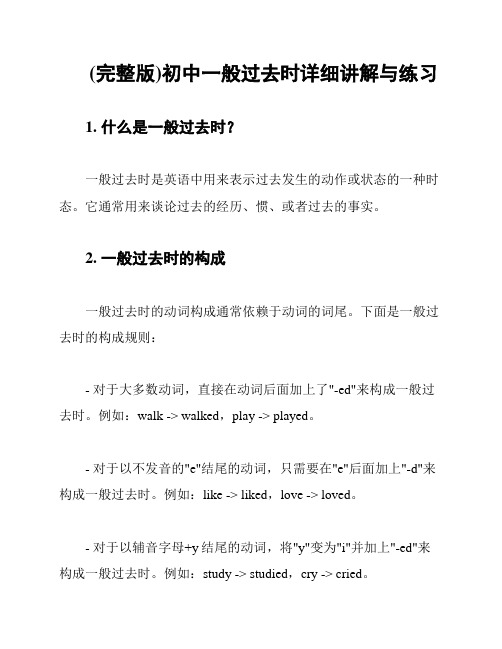
(完整版)初中一般过去时详细讲解与练习1. 什么是一般过去时?一般过去时是英语中用来表示过去发生的动作或状态的一种时态。
它通常用来谈论过去的经历、惯、或者过去的事实。
2. 一般过去时的构成一般过去时的动词构成通常依赖于动词的词尾。
下面是一般过去时的构成规则:- 对于大多数动词,直接在动词后面加上了"-ed"来构成一般过去时。
例如:walk -> walked,play -> played。
- 对于以不发音的"e"结尾的动词,只需要在"e"后面加上"-d"来构成一般过去时。
例如:like -> liked,love -> loved。
- 对于以辅音字母+y结尾的动词,将"y"变为"i"并加上"-ed"来构成一般过去时。
例如:study -> studied,cry -> cried。
- 部分动词的一般过去时需要进行不规则变化。
例如:go -> went,eat -> ate。
3. 一般过去时的用法一般过去时通常用来描述以下情况:- 过去发生的动作:I walked to school yesterday.- 过去的经历:He lived in London for five years.- 过去的事实:She was a teacher in the past.4. 一般过去时的句型练下面是一些练,帮助加深对一般过去时的理解和运用:1. 请用一般过去时填空:Yesterday, I ________ (watch) a movie at home.2. 完成句子:He _____ (visit) his grandparents last summer.3. 改写句子,使用一般过去时:I read a book yesterday. (改为否定句)4. 改写句子,使用一般过去时:They played basketball in the park. (改为疑问句)5. 总结一般过去时是用来表示过去发生的动作或状态的一种时态。
一般过去时详细讲解
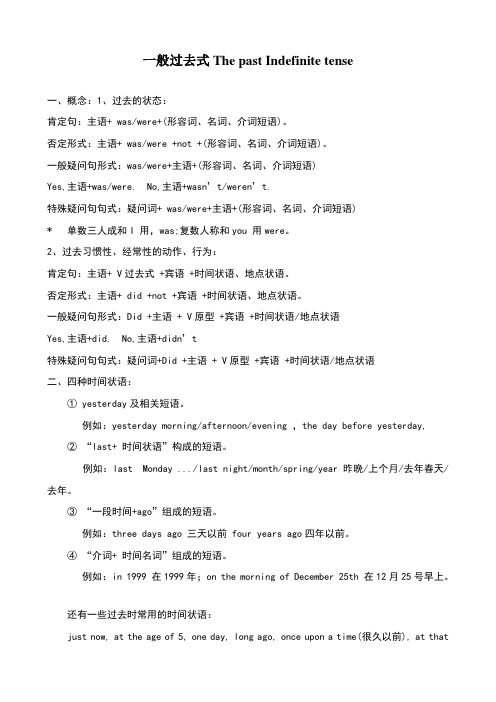
一般过去式The past Indefinite tense一、概念:1、过去的状态:肯定句:主语+ was/were+(形容词、名词、介词短语)。
否定形式:主语+ was/were +not +(形容词、名词、介词短语)。
一般疑问句形式:was/were+主语+(形容词、名词、介词短语)Yes,主语+was/were. No,主语+wasn’t/weren’t.特殊疑问句句式:疑问词+ was/were+主语+(形容词、名词、介词短语)* 单数三人成和I 用,was;复数人称和you 用were。
2、过去习惯性、经常性的动作、行为:肯定句:主语+ V过去式 +宾语 +时间状语、地点状语。
否定形式:主语+ did +not +宾语 +时间状语、地点状语。
一般疑问句形式:Did +主语 + V原型 +宾语 +时间状语/地点状语Yes,主语+did. No,主语+didn’t特殊疑问句句式:疑问词+Did +主语 + V原型 +宾语 +时间状语/地点状语二、四种时间状语:① yesterday及相关短语。
例如:yesterday morning/afternoon/evening ,the day before yesterday,② “last+ 时间状语”构成的短语。
例如:last Monday .../last night/month/spring/year 昨晚/上个月/去年春天/去年。
③ “一段时间+ago”组成的短语。
例如:three days ago 三天以前 four years ago四年以前。
④ “介词+ 时间名词”组成的短语。
例如:in 1999 在1999年;on the morning of December 25th 在12月25号早上。
还有一些过去时常用的时间状语:just now, at the age of 5, one day, long ago, once upon a time(很久以前), at thattime,before, a few days ago, when,the other day(前几天),When I was 8 years old (当我八岁时…),etc.三、过去时用法:① 表示在过去某个时间发生的动作或情况。
英语一般过去时语法知识讲解
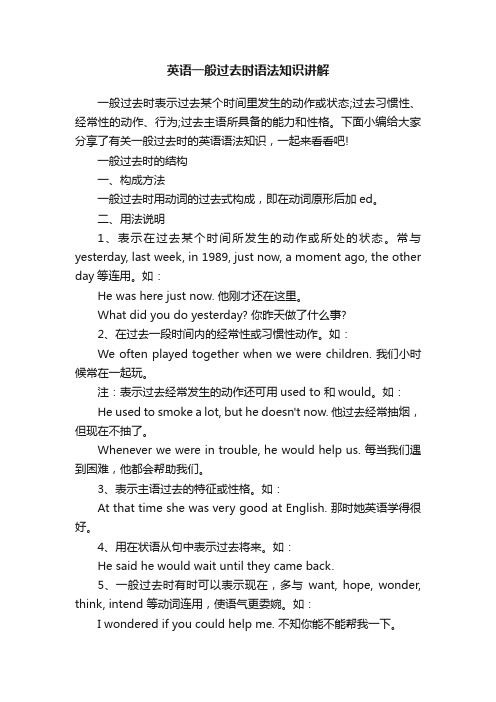
英语一般过去时语法知识讲解一般过去时表示过去某个时间里发生的动作或状态;过去习惯性、经常性的动作、行为;过去主语所具备的能力和性格。
下面小编给大家分享了有关一般过去时的英语语法知识,一起来看看吧!一般过去时的结构一、构成方法一般过去时用动词的过去式构成,即在动词原形后加ed。
二、用法说明1、表示在过去某个时间所发生的动作或所处的状态。
常与yesterday, last week, in 1989, just now, a moment ago, the other day等连用。
如:He was here just now. 他刚才还在这里。
What did you do yesterday? 你昨天做了什么事?2、在过去一段时间内的经常性或习惯性动作。
如:We often played together when we were children. 我们小时候常在一起玩。
注:表示过去经常发生的动作还可用used to 和would。
如:He used to smoke a lot, but he doesn't now. 他过去经常抽烟,但现在不抽了。
Whenever we were in trouble, he would help us. 每当我们遇到困难,他都会帮助我们。
3、表示主语过去的特征或性格。
如:At that time she was very good at English. 那时她英语学得很好。
4、用在状语从句中表示过去将来。
如:He said he would wait until they came back.5、一般过去时有时可以表示现在,多与want, hope, wonder, think, intend 等动词连用,使语气更委婉。
如:I wondered if you could help me. 不知你能不能帮我一下。
6、有时用一般过去时也是时态一致的需要。
一般过去时讲解已改
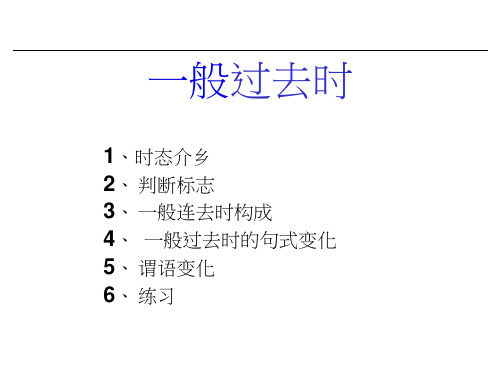
一般过去时1、时态介乡2、判断标志3、一般连去时构成4、一般过去时的句式变化5、谓语变化6、练习1.定义:(用法1)一般过去时态表示过去某个时间发生的动作或存在的状态,常和表示过去的时间状语连用;例句:I got up a/t 7:00 yes terday.My father was at work yesterday afternoon(用法二)也表示过去经常或反复发生的动作,常和表示频度的时间状语连用。
例句:He always went to work by bus last year.(含有频度副词:often always等,但全要还是含肴过去时间状语)2、一般过去时的判断标志:明确的过去时间状语1 •与ago连用? a moment two minutes three hours z five days one week six months 丿four years4•与one连用:morning evening©ne day、Monday afternoon5•与that连用:that morning winter day year6•其他时间状语:Just now in the old days inthose days in 1980 th® ©therd@# at that tiim once upon atime3、一般过去时的构成所有时态都是通过动词变化来表现的• E.g.•You are right.•一般现在时•I want to go to school.We are doing our housework nowThe bus is leaving at 8:oo.正在进行be 动词(was,were)助动词(did)(could,might)情态实义动词侑确切含义的动词,可以单独做谓语,如:played)•They were happy.•He played football.•You did your homework.主语+谓语■例如:4、一般过去时句式变换Ait去瞒旬武am疑问句式1•肯定句:主语+行为動闽过去式be 动词过去式(was / were)e.g> We played football yesterday.返回上页 返回首页I was in the office last night. He couldn^tswim 10 years ago.2•否定句did not / didn,t +行为动词原形was not / wasn^t + 其他成分were not / weren^t + 其他成分e.g. I was not in the office last night.I didn't sing a song at Kangkang's party.I didn't play video games.3. 一般疑问句did +主语+行为动词原形was / were +主语+其他成分eg. - Did you go shopping yesterday? -Yes, I did. / No, I didn't.・Was she 15 years old last year?4. 特殊疑问句特殊疑问词+did +主语+行为动词原形特殊疑问词+was / were +主语+其他成分eg. - Did you go shopping yesterday?When and where were you born?5、谓语变化规则动词过去式的构成构成规则1. 一般在动词原形末尾加・ed look lookedplay playedstart started2.结尾是e的动词加-d live livedhope hopeduse used3.末尾只有一个辅音字母的重读stop stopped闭音节词,先双写这个辅音字plan planned母,再加-ed trip tripled4.结尾是“辅音字母+y”的动词,study studied先变“y”为“i”再加-ed carry carried规则动词・ed的读音•说明:• 1、清念/V ,即ed在清辅音后面念1X15•例:finished helpedpassed cooked•元浊/d/,即ed在元音,浊辅音后面念/d/,例:borrowed enjoyedcalled moved•、/t/ /d/ 之后念/id/ 5即ed在/t/ /d/音后面念/id/例:wanted shouted needed counted不规则动词的过去式grow — grew know — knewthrow - threw blow — blew write — wrote drive ― drove ride — rode get - got forget — forgot lend — lent send — sent spend — spent say — said */sed/ pay — paid stand — stood understand — understood let — let put — put cut — cut read ■- read^am, is “ was are — were do — did go“ went have — had see ― saw can — could may — might dig — dug eat — ate find — found make — made hear — heard run —ran take — took hold — held speak - spoke leave ― leftkeep — kept sleep — slept sweep — swept tell — told sell — sold begin — began sing — sang sit — sat swim — swam ring — rang give — gave bring ― brought buy “ bought think - thought teach - taught catch - caught come — came become — became写出下列动词的过去式:go went use used run ranthink thought live lived borrow borrowed be was/ were wake woke grow grew happen happened keep kept watch watched give gave say said write wrote become became clean cleaned smile smiled get got buy bought open opened rain rained play played begin began stay stayed learn learnt/ed swim swam pass passed see saw carry carried answer answered read read study studiedstop stopped finish finished6、Exercises•山•句型转换一They came to China in 1990.(变一般疑问句)•Did theRme to China in 1990?•2」was ill for two days last week?(同上)•"g厂g you ill for two days last week?• 3. The twins go to school on foot every day.(同上)•Do the twins go to school on foot every day?• 4.She washed the clothes last Sunday.(变否定句)•She didn't wash the clothes last Sunday5. She is going to go shopping tomorrow.(变否定She isn't qoinq to qo shoppinq tomorrow.6. My mother likes her students.(变一般疑问句)Does you厂mother like her students?7. D o you watch TV on Sunday?(用last Sunday 改写成过去时态的句子)Did you watch TV last Sunday?.Wei Hua bought a new pen yesterday・(变否定She didn牛buy a new pen yesterday.用括号里动词的适当形式填空。
高中英语语法一般过去时详细讲解
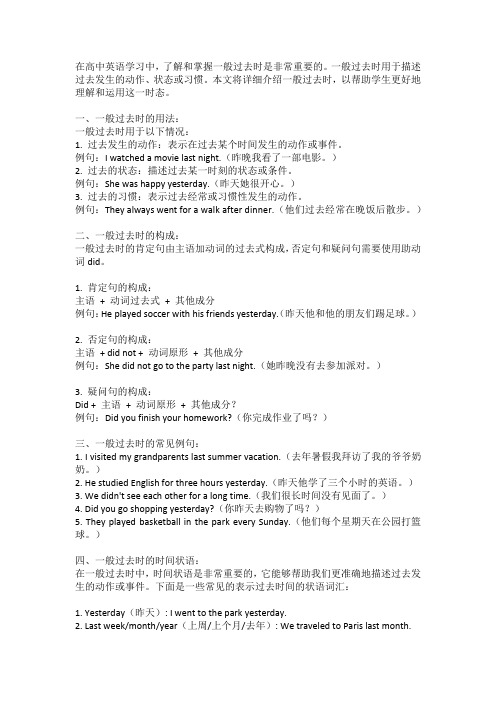
在高中英语学习中,了解和掌握一般过去时是非常重要的。
一般过去时用于描述过去发生的动作、状态或习惯。
本文将详细介绍一般过去时,以帮助学生更好地理解和运用这一时态。
一、一般过去时的用法:一般过去时用于以下情况:1. 过去发生的动作:表示在过去某个时间发生的动作或事件。
例句:I watched a movie last night.(昨晚我看了一部电影。
)2. 过去的状态:描述过去某一时刻的状态或条件。
例句:She was happy yesterday.(昨天她很开心。
)3. 过去的习惯:表示过去经常或习惯性发生的动作。
例句:They always went for a walk after dinner.(他们过去经常在晚饭后散步。
)二、一般过去时的构成:一般过去时的肯定句由主语加动词的过去式构成,否定句和疑问句需要使用助动词did。
1. 肯定句的构成:主语+ 动词过去式+ 其他成分例句:He played soccer with his friends yesterday.(昨天他和他的朋友们踢足球。
)2. 否定句的构成:主语+ did not + 动词原形+ 其他成分例句:She did not go to the party last night.(她昨晚没有去参加派对。
)3. 疑问句的构成:Did + 主语+ 动词原形+ 其他成分?例句:Did you finish your homework?(你完成作业了吗?)三、一般过去时的常见例句:1. I visited my grandparents last summer vacation.(去年暑假我拜访了我的爷爷奶奶。
)2. He studied English for three hours yesterday.(昨天他学了三个小时的英语。
)3. We didn't see each other for a long time.(我们很长时间没有见面了。
一般过去时讲解
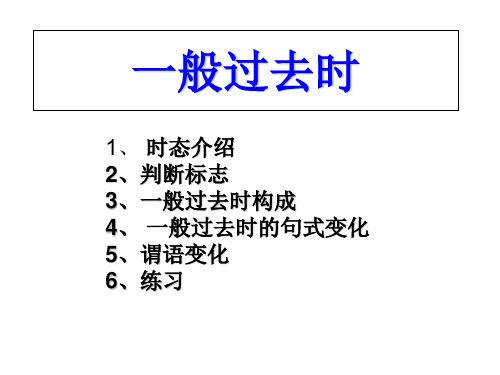
Yes,you did.
Yes,I did.
Yes,he/she/it did.
work
No,you did not. Did we work?
No, I did not. No,he/she/it did not. Did you work? Did they work?
Yes,we/you did. Yes,we did. Yes,they did. No,we/you did not. No,we did not. No,they did not.
•
时
•
be动词(was,were)
•
助动词(did)
主语+谓语 •
•
情态动词(could,might) 实义动词(有确切含义的动词,可
以单独做谓语,如:played
•
等)
例如:
• They were happy.
• He played football.
• You did your homework.
Was there a/ any…? there Yes,there was.
Were there any…? Yes,there were.
be No,there was not.
No,there were not.
返回上页 返回首页
1.肯定句:主语 + 行为动词过去式 be动词过去式(was / were)
e.g. We played football yesterday. I was in the office last night. He couldn’t swim 10 years ago.
2.否定句 did not / didn’t + 行为动词原形 was not / wasn’t + 其他成分 were not / weren’t + 其他成分
一般过去时讲解及练习
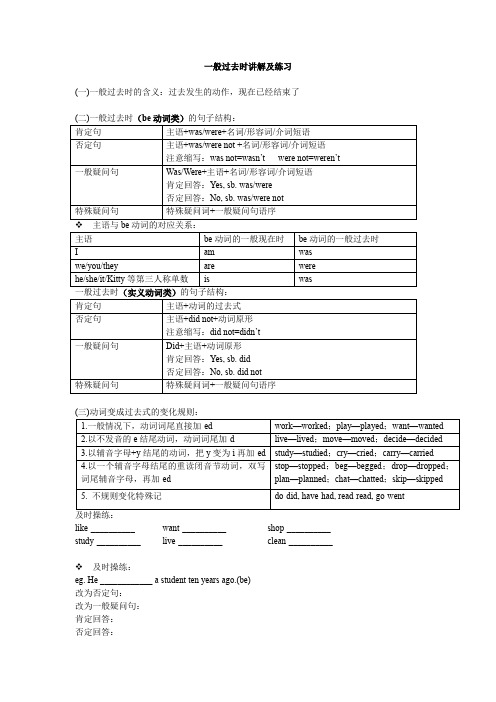
一般过去时讲解及练习(一)一般过去时的含义:过去发生的动作,现在已经结束了一般过去时(实义动词类)的句子结构:及时操练:like-__________want-__________shop-__________ study-__________live-__________clean-__________❖及时操练:eg. He ____________ a student ten years ago.(be)改为否定句:改为一般疑问句:肯定回答:否定回答:对ten years ago划线提问:(四)一般过去时的时间标志词1. yesterday昨天系列:yesterday昨天,yesterday morning昨天早上,the day before yesterday 前天2. last上一个系列:last year去年,last month上个月,last week上周3. ago以前系列:two minutes ago两分钟前, three hours ago三小时前, four days ago四天前4. just now刚才(五)一般过去时(be动词类)练习:I. 用所给词的适当形式填空1. I __________ at home just now. (be)2. They __________ happy last week. (be)3. She __________ a student ten years ago. (be)4. The old man __________ at church yesterday. (be)II. 按要求改写句子:1. I was at home just now. (改成否定句)I __________ __________ at home just now.2. They were happy last week. (改成一般疑问句)__________ __________ happy last week?3. She was a student ten years ago. (改成否定句)She __________ __________ a student ten years ago.4. The old man was at church yesterday. (对划线部分提问)__________ __________ the old man at church ?(七)一般过去时(实义动词类)练习:I. 用所给词的适当形式填空1. I _________ (have) an exciting party last weekend.2. _________ she _________(practice) her guitar yesterday? No, she _________.3. What ________ Tom ________ (do) on Saturday evening?He ________(watch) TV and __________(read) an interesting book.4. They all _________(go) to the mountains yesterday morning.5. She _________(not visit) her aunt last weekend.She ________ (stay) at home and _________(do) some cleaning.II. 按要求改写句子1. Lucy did her homework at home.(改否定句)Lucy ________ _______ her homework at home.2. He found some meat in the fridge.(变一般疑问句)___________ he __________ ___________ meat in the fridge?3. They studied English last year.(变一般疑问句)_______ they _______ English last year?4. Frank read an interesting book about history. (一般疑问句)_______ Frank _______ an interesting book about history?5. My family went to the beach last week. (划线提问)________ ________ ________ family _______ last week?。
一般过去时讲解PPT课件

did
助动词,用于构成一般过去时的 疑问句和否定句。
主语
句子中的动作执行者,可以是名 词、代词等。
例如
What did you do yesterday? 你 昨天做了什么?
其他成分
包括宾语、状语等,根据句子需 要而定。
动词原形
指动词的基本形式,即不加任何 时态或语态标记的形式。
特殊疑问句实例分析
when、after、 before、as等引导的 表示过去的时间状语 从句。
已经、曾经、刚才、 那时等表示过去的时 间副词。
02
一般过去时肯定句结构
主语+动词过去式+其他成分
01
02
03
主语
句子中的主体,可以是人 、物或抽象概念。
动词过去式
表示过去某个时间里发生 的动作或状态。动词的过 去式可分为规则变化和不 规则变化两种。
表示过去某个时间里发生的动 作或状态。
用法
陈述过去的事实或情况,描述 过去经常或反复发生的动作。
现在完成时
表示过去发生的动作对现在造 成的影响或结果,或从过去已 经开始,持续到现在的动作或 状态。
用法
强调过去与现在的联系,表达 一个动作从过去一直延续到现
在。
两者在时间状语上的区别
01
02
03
04
一般过去时
一般过去时讲解PPT课件
目录 Contents
• 一般过去时基本概念 • 一般过去时肯定句结构 • 一般过去时否定句结构 • 一般过去时疑问句结构 • 一般过去时特殊疑问句结构 • 一般过去时与现在完成时的比较
01
一般过去时基本概念
定义与作用
定义
一般过去时表示过去某个时间里 发生的动作或状态。
一般过去时讲解及答案

一般过去时讲解及答案一、巧记一般过去时:动词一般过去时,表示过去发生的事;be用was或用were, have,has变had;谓语动词过去式,过去时间作标志;一般动词加-ed,若是特殊得硬记。
否定句很简单,主语之后didn’t添;疑问句也不难,did放在主语前;不含be动词时如果谓语之前有did,谓语动词需还原;动词若是was,were,否定就把not添。
含be动词时疑问句也不难,要把was,were放在主语前。
二、be的一般过去时:学习动词be的一般过去时,下面有一口诀,它可以帮你们更好地掌握动词be的一般过去时。
be的过去时有四巧:一是时间状语巧,表示过去的短语要记牢;二是形式巧,单数was,复数were;三巧是否定句结构,not紧跟was/were;四是疑问句式巧,was/were向前跑(提前)。
【一巧】时间状语(即标志词)巧。
一般过去时表示过去发生的动作或存在的状态,恰巧与表示过去的一些时间状语连用。
【二巧】形式巧。
它与一般现在时一样,形式多样:当主语是第一人称单数或第三人称单数时,谓语动词用was;主语是第二人称或其他人称复数时,谓语动词用were。
例如: I was in the classroom yesterday morning.昨天早上我在教室里。
He was at school last Tuesday.上周二他在学校。
They were over there a moment ago.刚才他们在那边。
【三巧】否定句结构巧。
与动词be的一般现在时一样,它在动词后面加not即可变成否定句,并且was, were与not可以缩写成wasn't, weren't。
即:主语+ wasn't/ weren't +表语+其他。
例如:I was not (=wasn't) here yesterday.昨天我不在这儿。
My parents were not (=weren't) at home last Sunday.上周日我父母不在家。
一般过去时讲解

05
一般过去时的注意事项
避免与现在完成时的混淆
01
区别动作发生的时间点
一般过去时表示过去某个时间发生的动作或存在的状态,而现在完成时
强调的是动作从过去一直持续到现在,可能还会持续下去。
02 03
注意时间状语的运用
一般过去时通常与表示过去的时间状语连用,如yesterday、last year 等,而现在完成时则常与表示现在的时间状语连用,如so far、up to now等。
在描述历史事实中的应用
描述历史事件,例如“The Declaration of Independence was signed in 1776”(《独立宣言》于 1776年签署)。
描述历史人物的行为或遭遇,例如“Napoleon Bonaparte conquered much of Europe in the early 19th century”(拿破仑·波拿巴在19世纪初征服了欧洲的大部分地区)。
一般过去时讲解
目录
• 一般过去时的定义 • 一般过去时的动词变化 • 一般过去时的句型结构 • 一般过去时的语境应用 • 一般过去时的注意事项
01
一般过去时的定义
什么是一般过去时
01
一种描述过去发生的动作或状态 的时态。
02
表示过去某个时间点、某段时间 或某个情境下的动作或状态。
一般过去时的语法形式
动词时态的一致性
在描述一系列动作时,应注意保持动词时态的一致性,避免混淆。
注意时间状语的使用
准确运用时间状语
使用一般过去时需要准确选择和运用 时间状语,如使用ago表示过去的某 个时间点,使用just now表示刚刚发 生的动作。
避免使用模糊的时间状语
一般过去时讲解
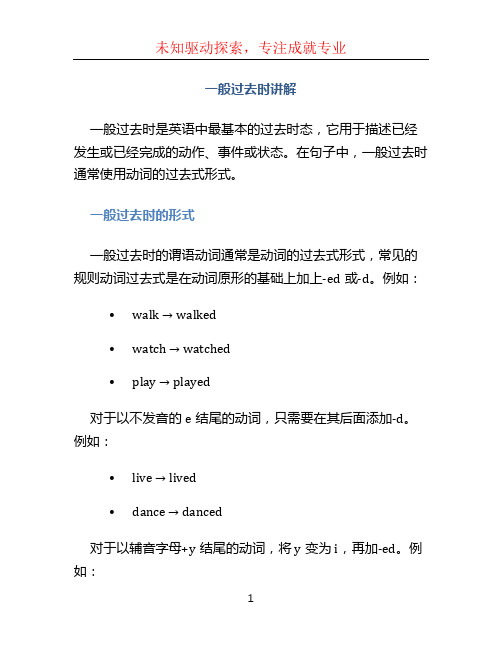
一般过去时讲解一般过去时是英语中最基本的过去时态,它用于描述已经发生或已经完成的动作、事件或状态。
在句子中,一般过去时通常使用动词的过去式形式。
一般过去时的形式一般过去时的谓语动词通常是动词的过去式形式,常见的规则动词过去式是在动词原形的基础上加上-ed或-d。
例如:•walk → walked•watch → watched•play → played对于以不发音的e结尾的动词,只需要在其后面添加-d。
例如:•live → lived•dance → danced对于以辅音字母+y结尾的动词,将y变为i,再加-ed。
例如:•study → studied•try → tried对于以短元音字母结尾的重读闭音节动词,需要先双写最后一个辅音字母,再加-ed。
例如:•stop → stopped•plan → planned不规则动词的过去式需要特殊记忆。
例如:•go → went•have → had•say → said一般过去时的用法1.描述过去的动作或事件一般过去时常用于描述过去发生的动作或事件。
例如:–I walked to the park yesterday.(我昨天走到了公园。
)–They played soccer last weekend.(他们上个周末踢了足球。
)2.描述过去的习惯或常态一般过去时还可用于描写过去的习惯或常态,表示过去经常发生的动作或状态。
通常会和表示频率的副词或状语连用,如often(经常)、usually(通常)、always (总是)等。
例如:–He often visited his grandmother when he lived in the city.(他住在城市时经常去看他的奶奶。
)–I always went to bed early when I was a child.(我小时候总是很早就睡觉。
)3.用于虚拟语气一般过去时也可用于虚拟语气,表示对现在或将来的假设或建议。
完整版)一般过去时讲解及练习

完整版)一般过去时讲解及练习一般过去时是用来描述在确定的过去时间里所发生的动作或存在的状态。
常见的时间状语有yesterday、an hour ago、the other day、XXX、last night/week/month/year、a moment ago、a week ago、three years ago、just now和in the past等。
例如:“Where did you go just now?”(你刚才去哪了?)。
一般过去时的谓语动词形式为动词的过去式,一般在动词原形后加-ed。
例如:“I was tired last night.”(昨天晚上我很累)和“XXX.”(昨天我们参观了那个博物馆)。
一般过去时的构成有两种方式。
第一种是用was/were+形容词/名词等。
例如:“I was XXX.”(昨天我在家)和“Mr.Green was not a teacher last year.”(去年XXX不是一个老师)。
系动词be的过去式为am/is→was、are→were。
第一人称单数(I)和第三人称单数(he/she/it)用was,第二人称单数(you)和各人称复数(we/you/they)用were。
第二种是用实义动词的过去式+其他成分。
例如:“XXX.”(我妈妈昨天去购物了)和“His uncle worked in Beijing in 2014.”(他叔叔2014年在北京工作)。
一般过去时的句式有三种。
肯定句的形式是主语+was/were+其他或主语+实义动词的过去式+其他。
例如:“XXX.”(上周日我去探望了爷爷)和“I was not at school at this time yesterda y.”(昨天的这个时候我没在学校)。
否定句的形式是主语+did+not+实义动词的原形+其他。
例如:“XXX.”(上周我什么都没买)。
疑问句的形式是Was/Were+主语+其他?例如:“Was she at home yesterday?”(昨天她在家吗?)Did you have a good time last weekend。
一般过去时讲解

一般过去时讲解
一般过去时的常见错误
时态不一致:在描述过去的事情时,容易将一些动作的时态与一般过去时不一致,导 致意思表达不清或产生歧义 动词形式错误:在使用一般过去时的时候,容易将动词的形式拼写错误或使用不当, 导致句子意思错误或语法错误
写作练习:通过写作练习来巩固一般过去时的运用。可以写日记、故事、短文等,记 录过去发生的事情,用一般过去时描述动作和状态。在写作过程中,注意时态的准确 性和语法的规范性
一般过去时讲解
口语练习
在口语练习中,尝试使用一般过去 时来描述过去的事情,表达对过去 的看法和回忆。可以通过模拟对话、 角色扮演等方式进行练习,提高对
pmห้องสมุดไป่ตู้ 我们原本打算下午3点在
火车站见面
03
表示过去的虚拟语气
在表示与现实相反的情况时, 可以使用一般过去时,表示虚 拟语气。例如:If I had known the answer, I would have told you. 如果我知道 答案的话,早就告诉你了。 (实际上不知道答案)
04
表示对过去的推测
在表示对过去的推测时,可以 使用一般过去时。例如:It must have rained last night, because the ground is wet. 昨晚一定下雨了,因 为地面是湿的
一般过去时讲解
一般过去时的其他注意事项
注意动词时态的一致性:在使用一般过去时的时候,要注意句子中其他动词的时态与 之一致。例如,在描述过去发生的事情时,所有的动作都应使用过去时态,除非有特 殊需要使用其他时态 注意动词的形式:在一般过去时中,动词需要使用其过去式形式。不同形式的动词过 去式有不同的拼写和发音,需要注意正确使用 注意时间状语的搭配:在使用一般过去时的时候,要与适当的时间状语进行搭配。例 如,"yesterday"应与一般过去时搭配使用,"tomorrow"应与一般将来时搭配使用
- 1、下载文档前请自行甄别文档内容的完整性,平台不提供额外的编辑、内容补充、找答案等附加服务。
- 2、"仅部分预览"的文档,不可在线预览部分如存在完整性等问题,可反馈申请退款(可完整预览的文档不适用该条件!)。
- 3、如文档侵犯您的权益,请联系客服反馈,我们会尽快为您处理(人工客服工作时间:9:00-18:30)。
英语时态之一般过去时讲解I .Teachi ng aims and dema nds1. Review past simple tense2. Lear n how to describe what some one did3. Review the rules of the past forms of the verbsn . Teaching importanee and difficultiesThe rules of the past forms of the verbs川.Teaching aidsSmall blackboard papersIV . Teaching proceduresStep 1 Review1. Greeting2. Practice everyday English: do pair workGroup 1:The teacher gives the example and practice one by one like this,A: What did you do last Su nday?B: I…Group 2: The teacher gives the example and practice one by one like this,A: What did she/he do last Su nday?B: She/he …Step 2 Prese ntati on一.一般过去时的基本用法1. 一般过去时表示过去某个时间发生的动作或存在的状态,常和表示过去的时间状语连用。
1. yesterday 或以其构成的短语:yesterday morning(afternoon, evening等;2. 由last+ 一时间名词”构成的短语:last n ight, last year (wi nter, mon th, week等;3. 由时间段+ago”构成的短语:a moment ago, a short time ago, an hour ag等;4. 其它:just now 等5. 由某些表示过去时态的从句等:when I was ten years old. 女口:he was late yesterday.I did my homework three hours ago.I came home just now.2. 表示过去习惯性、经常性的动作.常与often,always 等连用。
女口:He always carried a book.二.一般过去式的构成形式1. Be动词在一般过去时中的变化:⑴am 和is 在一般过去时中变为waso( was not=wasn't )⑵are 在一般过去时中变为were°( were not=weren't )⑶带有was或were的句子,其否定、疑问的变化和is, am, are 一样,即否定句在was或were后加not, —般疑问句把was或were调到句首。
2. 句中没有be动词的一般过去时的句子否定句:did n't + 动词原形,如:Jim went home yesterday.Jim did n't go home yesterday.一般疑问句:在句首加did,句子中的动词过去式变回原形。
女口:Jim went home yesterday.Did Jim go home yesterday?特殊疑问句:⑴疑问词+—般疑问句?如:Jim went home yesterday.Did Jim go home yesterday?Step 3 The rules of the past forms of the verbs三、规则动词的过去式1. 一般情况下,在动词原形后面加-ed。
look f looked play —played start —started visit —visited2. 以不发音e结尾的动词,在词尾直接加-d olive —lived use—used3. 以辅音字母+ y”吉尾的动词,先将y改为i ,再加-ed。
study —studied try —tried fly —flied4. 以重读闭音节(即辅音+元音+辅音)或r音节结尾,末尾只有一个辅音字母的动词,要先双写这个辅音字母后,再加-ed。
stop —stopped pla n —pla nned prefer —preferred5. 不规则动词的过去式需特殊记忆女口: am (is )-was, are-were (是),go-went (走),come-came (来) take-took (拿),have (has )-had (有), begin (开始)--began.bring (拿来)--brought, can (能)--could, catch (捉住)--caught, cut (砍,害U ) --cut, do/does (做,干)--did, draw (画画,拉)--drew, drink (喝)--drank, drive (驾驶)--drove, eat (吃)--ate,fall (跌倒,落下)--fell, feel (感觉)--felt, fly (飞)--flew, get (获得)--got, give (给)---gave, grow (生长)--grew, keep (保持)--kept, know (知道,认识)--knew, learn (学习)--learnt,leave (离开)--left, let (让)--let, lie (躺,平放)--lay,--might, must (必须)--must, ring (鸣铃)--rang, see (看见)--saw, set (放)--set,sleep (睡觉)--slept,swim (游泳)--swam, teach (教)--taught, tell (告诉)--told, think (认为)--thought, throw (投掷)--threw, understand (懂得)--understood, wear (穿)--wore, will (将要)--would, win (获胜)--won,Step 4 Project1. Review the past simple tense.2. Homework附:一般过去时口诀:动词一般过去时,表示过去发生的事; be 用was 或用were,have,has 变 had ;谓语动词过去式,过去时间作标志;一般动词加 -ed ,若是特 殊得硬记。
否定句很简单,主语之后didn 't 添;疑问句也不难,did 放在主语前;‘不含be 动词时如果谓语之前有did ,谓语动词需还原; 动词若是was,were,否定就把not 添。
}含be 动时 疑问句也不难,要把was were 放在主语前。
一般过去时练习题 I. 请用正确动词形式填空 make (使得,做)- -made,may (可以) read (读)--read, ride (骑)--rode, run (跑)--ran, say (说)--said,sell (卖)--sold, send (送)--sent, sing (唱歌)--sang, sit (坐)--sat, (花费)--spent, stand (站立)--stood, speak (说话)--spoke, spend1. He lived (live) in Wuxi two years ago.2. The cat ate ________ (eat) a bird last ni ght.3. We had ________ (have) a party last Hallowee n.4. Nancy picked __________ (pick) up oran ges on the farm last week.5. I made (make) a model ship with Mike yesterday.6. They played _________ (play) chess in the classroom last PE less on.7. My mother cooked ___________ (cook) a n ice food last Spring Festival.8. The girls ____ danced ____ (dance) at the party last night.9. I ______ (watch) a carto on on Saturday last week.10. ___ Did ___ y ou __visit ____ (visit) your relatives last Spring Festival?11. _____ Did_ he ___ fly ___ (fly) a kite on Sun day? Yes, he __did __ .12. Gao Sha n __ put __ (put) up the picture last ni ght.13. I ______ swept ____ (sweep) the floor yesterday.14. What __did ___ she ___ find ___ (find) in the garde n last morning?15. Her father ____ read__ (read) a n ewspaper last ni ght.16. Mike _____ d idn 'go ____________ (not go) to bed until 12 oclock last 'n ight.17. I liste ned but _ heared _______ (hear) nothing.18. How many people ____ were __ (be) there in your class last term?II.改错题1 . How is Jane yesterday? ___ was __________________2. He go to school by bus last week. ____ went _______________________3. He ofte n goes home at 6:00 last mon th.__ went ______________________4. I can fly kites seve n years ago. ___________________ c ould __________5. Did you saw him just now._______________ s ee ___________________m.按要求变换句型1. Frank read an in teresti ng book about history. (一般疑问句)__ Did ___ Frank __read _____ an in terest ing book about history?2. He cleaned his room just now.. (戈U线提问)What _ did ____ he __does ____ ?3. Thomas spent RMB 10 on this book. (否定句)Thomas ______ didn 'spend __________ R MB 10 on this book.4. My family went to the beach last week.(划线提问)。
